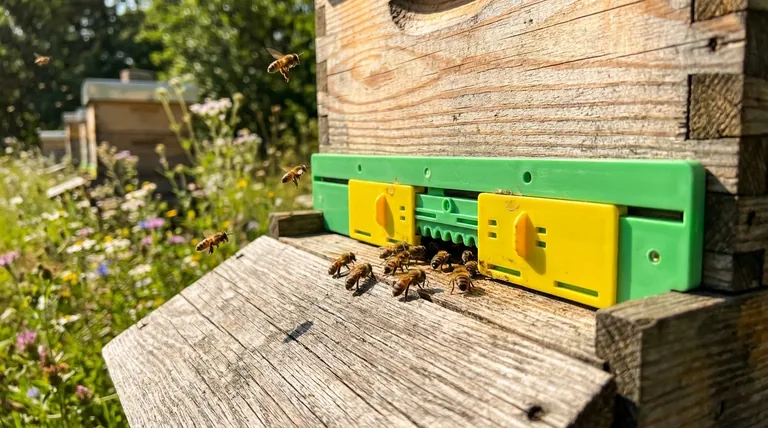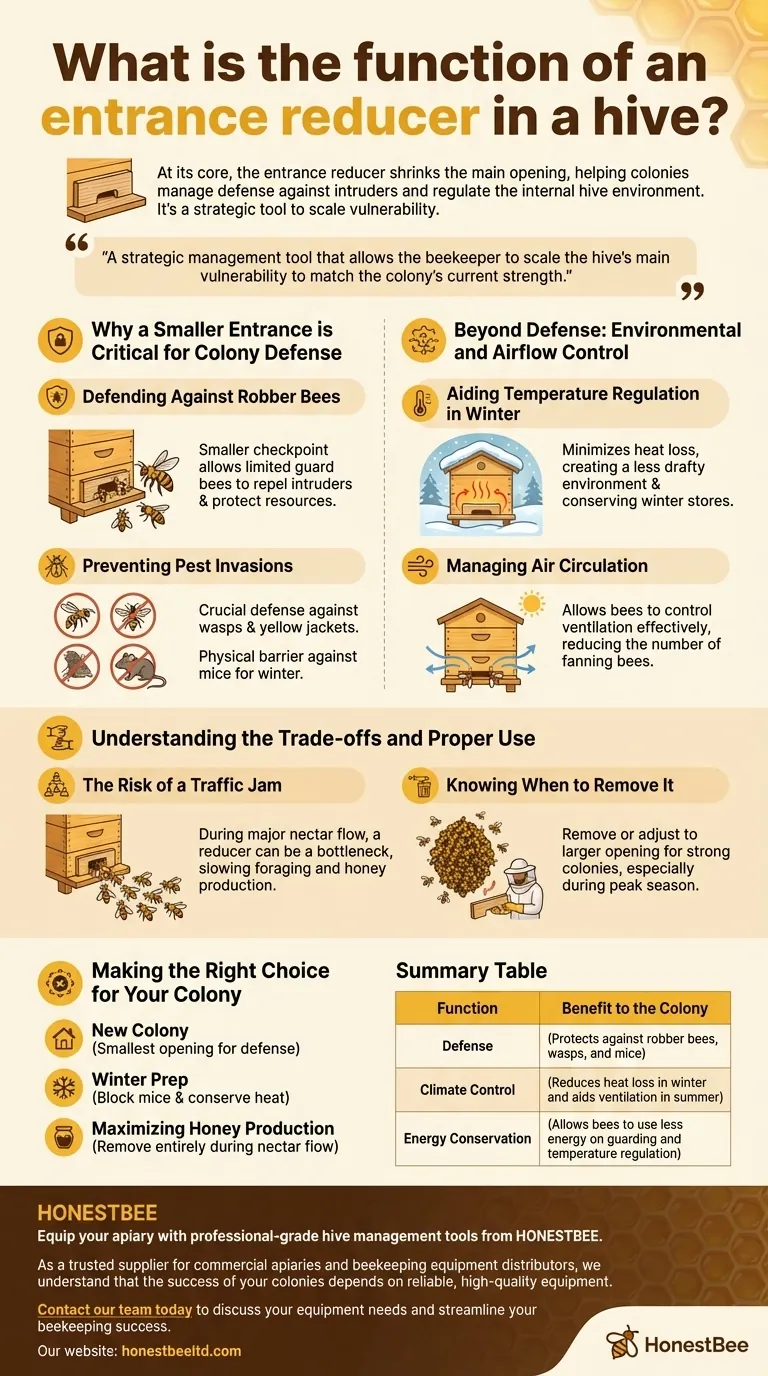At its core, the function of a hive entrance reducer is to shrink the main opening of the beehive. This simple wooden block is a critical tool for helping a honey bee colony manage its two greatest challenges: defense against intruders and regulation of the internal hive environment. It effectively reduces the size of the "front door" the bees must guard and maintain.
The entrance reducer is not merely a barrier; it is a strategic management tool that allows the beekeeper to scale the hive's main vulnerability to match the colony's current strength, conserving the bees' energy for growth and survival.

Why a Smaller Entrance is Critical for Colony Defense
A standard hive entrance is designed for a full-strength colony at the peak of the season. For smaller or weaker colonies, this large opening is a significant liability.
Defending Against Robber Bees
A new or small colony has fewer guard bees available to patrol the entrance. A wide, open entrance is an open invitation for "robber" bees from stronger, nearby hives to invade and steal honey stores.
By reducing the entrance, you create a smaller, more manageable checkpoint. This allows the limited number of guard bees to effectively repel intruders and protect their vital resources.
Preventing Pest Invasions
The reducer is a crucial line of defense against a variety of pests. Wasps and yellow jackets, which can prey on bees and steal honey, find it much more difficult to slip past the guards at a constricted entrance.
More importantly, it serves as a physical barrier against larger pests. Mice and other rodents seeking a warm, food-filled place to spend the winter are blocked by a reducer, which is why it is essential for winter preparations.
Beyond Defense: Environmental and Airflow Control
The entrance reducer also plays a key role in helping the bees manage their internal climate, which directly impacts their energy consumption and survival.
Aiding Temperature Regulation in Winter
During cold weather, the bee cluster must generate heat to survive, consuming their stored honey as fuel. A large, open entrance allows a significant amount of this precious heat to escape.
Reducing the entrance minimizes this heat loss, creating a less drafty environment. This helps the colony stay warm more efficiently, conserving their winter food stores.
Managing Air Circulation
While it may seem counterintuitive, a smaller entrance can also help with summer cooling. It allows the bees to control the hive's ventilation more effectively.
This reduces the number of bees that must engage in fanning at the entrance to circulate air, freeing them up for other vital tasks like foraging.
Understanding the Trade-offs and Proper Use
While invaluable, an entrance reducer is not a permanent fixture. Using it at the wrong time can hinder a colony's progress.
The Risk of a Traffic Jam
For a strong, populous colony during a major nectar flow, a reducer is a significant bottleneck. Thousands of forager bees will be trying to get in and out simultaneously.
A reduced entrance creates a traffic jam, slowing down foraging operations and ultimately reducing the amount of honey the colony can produce. It can also contribute to overheating in a very strong hive.
Knowing When to Remove It
The key is to match the entrance size to the colony's needs. Once a new colony has grown strong and has enough bees to defend the full entrance, the reducer should be adjusted to a larger opening or removed entirely, especially during peak season.
Making the Right Choice for Your Colony
Your decision to use a reducer should be based on the colony's current strength and the time of year.
- If your primary focus is establishing a new colony: Use the smallest opening to give the small population maximum defensive advantage while they build their numbers.
- If your primary focus is preparing a hive for winter: Use the reducer to block mice and help the bee cluster conserve heat and food stores.
- If your primary focus is maximizing honey production in a strong hive: Remove the reducer entirely during the main nectar flow to prevent a bottleneck and ensure foragers have unrestricted access.
This simple piece of wood gives you precise control over your hive's biggest vulnerability, empowering you to help your bees thrive.
Summary Table:
| Function | Benefit to the Colony |
|---|---|
| Defense | Protects against robber bees, wasps, and mice. |
| Climate Control | Reduces heat loss in winter and aids ventilation in summer. |
| Energy Conservation | Allows bees to use less energy on guarding and temperature regulation. |
Equip your apiary with professional-grade hive management tools from HONESTBEE.
As a trusted supplier for commercial apiaries and beekeeping equipment distributors, we understand that the success of your colonies depends on reliable, high-quality equipment. An entrance reducer is just one of the many essential tools that can make a significant difference in colony health and honey production.
Let HONESTBEE support your operations with our wholesale-focused range of durable beekeeping supplies. Contact our team today to discuss your equipment needs and streamline your beekeeping success.
Visual Guide

Related Products
- Multi-Functional Sliding Hive Entrance for Beekeeping
- Multi-Functional Rotary Hive Entrance Disc for Beekeeping
- HONESTBEE Advanced Ergonomic Stainless Steel Hive Tool for Beekeeping
- Professional Reversible Beehive Hive Entrance
- HONESTBEE Professional Long Handled Hive Tool with Precision Cutting Blade
People Also Ask
- How does entrance configuration vary seasonally for beekeepers? A Guide to Year-Round Hive Health
- How does the sliding design of the entrance reducer benefit beekeepers? Achieve Ultimate Hive Control
- What size is the entrance hole in a native bee hive? The 13mm Standard for a Thriving Colony
- What additional functions do hive entrances serve? A Key to Colony Health, Security, and Productivity
- Why is a smaller entrance size beneficial for a beehive? Boost Hive Defense & Productivity



















